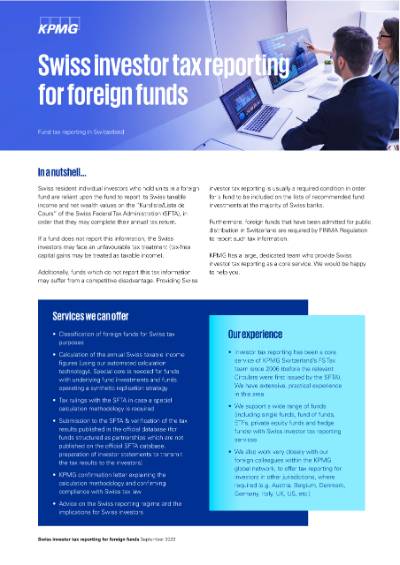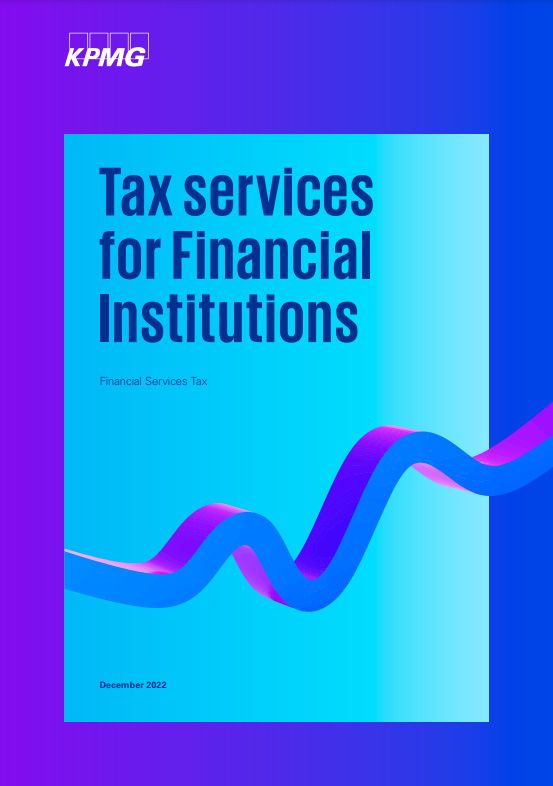Finanzdienstleister müssen sich den immer grösseren Herausforderungen im komplexen Steuerumfeld von heute stellen. Die erfolgreiche Bewältigung dieser Herausforderungen erfordert massgeschneiderte Lösungen.
Unser interdisziplinäres Team verfügt über das erforderliche Wissen im Bereich der Schweizer und internationalen Steuern sowie über ein tiefes Verständnis des wirtschaftlichen und regulatorischen Umfelds.
Unser Team widmet sich der Betreuung von Kunden schweizweit sowie international und betreibt Niederlassungen in Zürich und Genf.
Wir unterstützen Sie bei einer Vielzahl von Themen und haben umfassende Erfahrung in der Beratung von Finanzdienstleistern, darunter:
- Banken
- Händler/Broker
- Vermögensverwalter
- Fondsverwalter
- Versicherer
- Treuhänder
- Pensionskassen
- FinTech-Unternehmen
Unsere Steuerdienstleistungen für Finanzinstitute
Kompetenzen und Dienstleistungen der KPMG
Steuer-Compliance-Dienstleistungen für Finanzinstitute
Wir unterstützen Finanzinstitute in allen Bereichen der Steuer-Compliance, einschliesslich der Schweizer Unternehmensteuer, Verrechnungssteuer, Mehrwertsteuer, Stempelsteuer und andere Schweizer Steuerarten, von der Steuererklärung bis hin zur Kommunikation mit den Steuerbehörden.
Wir nutzen verschiedene Technologien, insbesondere KPMG’s Digital Gateway, um den Prozess der Steuer-Compliance weiter zu optimieren.
Thomas Brotzer
Leiter Financial Services Tax Schweiz, Leiter Global Insurance Tax, Mitglied des Verwaltungsrats
KPMG Schweiz
Beratung und Unterstützung im Bereich Financial Services Tax
Wir unterstützen bei der Bewältigung der komplexen steuerlichen Herausforderungen im Finanzdienstleistungssektor und entwickeln pragmatische Lösungen, die den rechtlichen und regulatorischen Anforderungen sowie den Best Practices der Branche entsprechen.
Dies umfasst:
- Fusionen und Übernahmen (Tax Due Diligence)
- Strukturierung/Umstrukturierung
- Steuerrevisionen
- Steuer-Rulings/-gutachten
- Health-Checks
- Steuerbuchhaltung
- Steuerliche Einstufung von Finanzinstrumenten mithilfe unserer "Automated Tax Sections"-Technologie – siehe Video für weitere Informationen
- Analyse der steuerlichen Eignung von Anlageprodukten (Tax Guides)
- Steuerliche Risikobeurteilung/steuerliches Risikomanagement
- Unterstützung bei Verrechnungspreisen (Transfer Pricing)
- Steuer-Hotline
- Steuerliche Behandlung digitaler Vermögenswerte (Blockchain, Krypto-Token, Distributed Ledger Technology (DLT))
Grégoire Winckler
Partner, Financial Services Tax
KPMG Schweiz
Operationelle Steuern (inkl. QI, FATCA und AIA)
Unser Team verfügt über langjährige Erfahrung in der Betreuung von Schweizer und internationalen Kunden in sämtlichen Aspekten der US-Regelungen hinsichtlich Qualified Intermediary ("QI"), Foreign Account Tax Compliance Act ("FATCA") und des automatischen Informationsaustausches ("AIA") sowie im Hinblick auf alle anderen Arten von operationellen Steuern. So bieten wir insbesondere:
- Laufende Unterstützung bei Compliance und Reporting
- Regelmässige QI-/FATCA-Überprüfungen
- Unterstützung bei der Zertifizierung als Responsible Officer (siehe unsere aktuellen Umfrageergebnisse hier - Inhalt auf Englisch)
- Health-Checks
- Richtlinien und Formulare für das Onboarding von Kunden
- Risikokontrollkonzepte
- Flowcharts und Checklisten
- Individuelle Schulungen je nach Anforderungen Ihrer Organisation
- Unterstützung bei Quellensteuer, Stempelsteuer, Transaktionssteuer
Jason Zücker
Director, Financial Services Tax
KPMG Schweiz
Steuerdienstleistungen für Vermögensverwalter
Wir unterstützen Vermögensverwalter und Pensionskassen mit einer breiten Palette an Steuerdienstleistungen, darunter:
- Steuerreporting für Schweizer Anleger (siehe Flyer)
- Strukturierung/Umstrukturierung von Fonds
- Investitionsprüfungen/Tax Due Diligence
- Rückforderung Schweizer und ausländischer Quellensteuer
- Analyse im Bereich der Schweizer Stempelsteuer
- Analyse im Bereich der Mehrwertsteuer
- Unterstützung bei Verrechnungspreisen (Transfer Pricing)
Chris Goddard
Director, Financial Services Tax
KPMG Schweiz
Steuerrechtliche Streitigkeiten
Wir arbeiten eng mit unseren Kunden zusammen, um möglichen steuerrechtlichen Streitigkeiten vorzubeugen, bieten aber auch gezielte und pragmatische Beratung, um unsere Kunden im Bedarfsfall vom Aufkommen eines Streits bis zu dessen Beilegung zu unterstützen.
Wir verteidigen die Interessen von schweizerischen und ausländischen Finanzinstituten bei steuerrechtlichen Streitigkeiten vor dem schweizerischen Bundesgericht, dem Bundesverwaltungsgericht und den Gerichten der einzelnen Kantone.
Charles Hermann
Partner, Financial Services Tax
KPMG Schweiz
Multishore Tax Reporting (MTR)
KPMG Schweiz bietet mit "Multishore Tax Reporting (MTR)" eine erfolgreiche Technologie für die Steuer-Compliance an, die eine einfache und effiziente Lösung zur Erstellung automatisierter Steuerverzeichnisse für die nationale und internationale Kundschaft von Schweizer Banken darstellt.
Für weitere Informationen zu unserem Multishore Tax Reporting klicken Sie hier.
Heiko Kubaile
Partner, Leiter German Tax & Legal Center und Leiter Multishore Tax Reporting
KPMG Schweiz
Transfer Pricing Dienstleitungen für Finanzinstitute
Wir unterstützen Finanzinstitute bei allen Aspekten im Bereich Verrechnungspreise. Unsere engagierten Experten im Financial Services Transfer Pricing Team helfen Ihnen Ihr Verrechnungspreissystem zu überprüfen und Risiken und Chancen im Zusammenhang mit den spezifischen konzerninternen Transkationen in der Finanzbranche zu identifizieren. Wir unterstützen Sie bei der Planung nachhaltiger und pragmatischer Verrechnungspreissysteme, die Ihren Geschäftsanforderungen entsprechen. Weiterhin unterstützen wir bei der Compliance und helfen in Streitfällen wie z.B. Steuerprüfungen, Vorabverständigungsverfahren, Steuer Rulings etc.
Um mehr über das zu erfahren, klicken Sie hier: Leistungen im Verrechnungspreisbereich.
Gerhard Foth
Partner, Global Transfer Pricing Services
KPMG Schweiz
BEPS 2.0
Wir unterstützen Finanzinstitute dabei, die steuerlichen Auswirkungen der neuen Nexus- und Gewinnaufteilungsregeln (Säule 1) sowie der globalen Mindestbesteuerung (Säule 2) zu verstehen.
Wir geben Einblicke in die wichtigsten Herausforderungen, die sich aus der Einführung von BEPS 2.0 ergeben, und finden klare Antworten auf die von den Modellregeln aufgeworfenen Fragen. Insbesondere bieten wir:
- Workshops
- Impact Assessments und Gap-Analysen
- Prozessdefinition und -strukturierung
- Projektimplementierung
- Schulungen
- Klicken Sie hier, um mehr über BEPS 2.0 zu erfahren.
Thomas Brotzer
Leiter Financial Services Tax Schweiz, Leiter Global Insurance Tax, Mitglied des Verwaltungsrats
KPMG Schweiz
IFRS 17
Wir unterstützen Versicherungsgesellschaften bei der Umsetzung des neuen internationalen Rechnungslegungsstandards für Versicherungsverträge IFRS 17 aus steuerlicher Sicht. Dies umfasst:
- Impact Assessments (einschliesslich Ansatz, Bewertung und Ausweis)
- Analyse der Wechselwirkung zwischen IAS 12 (Ertragsteuern) und IFRS 17 (Versicherungsverträge) für den Einzelfall (z. B. steuerliche Behandlung der Versicherungsnehmer und Auswirkungen auf den Erfüllungswert usw.)
Klicken Sie hier, um mehr über IFRS 17 zu erfahren.
Markus Portmann
Director, International Corporate Tax
KPMG Schweiz
DLT
Wir unterstützen Unternehmen im Finanzdienstleistungssektor bei der steuerlich effizienten und steuerkonformen Durchführung ihrer Transaktionen und Geschäftsaktivitäten im Zusammenhang mit DLT- und Blockchain-Technologien. Unsere Dienstleistungen umfassen unter anderem:
- Klarstellung der korrekten mehrwertsteuerlichen Behandlung sowie der Datenerfordernisse für sämtliche Bankdienstleistungen im Zusammenhang mit digitalen Vermögenswerten (Wallet-Dienste, Custody, Handel, Staking usw.).
- Unterstützung bei der Ausgabe von Tokens (Gewinnsteuer, Verrechnungssteuer, Stempelsteuer, Mehrwertsteuer).
- Unterstützung bei der Qualifizierung von Tokens für schweizerische Steuerzwecke.
- Prüfung, ob Transaktionen mit digitalen Vermögenswerten der Umsatzabgabe oder Verrechnungssteuer unterliegen.
- Bereitstellung von Lösungen für die steuerliche Berichterstattung und Kontoauszüge im Zusammenhang mit digitalen Vermögenswerten/Transaktionen.
- Beurteilung der steuerlichen Behandlung von Investitionen in digitale Vermögenswerte durch Privatpersonen.
- Unterstützung bei der Vorbereitung auf den Informationsaustausch im Zusammenhang mit digitalen Vermögenswerten.
- Steuerberatung bei der Aufsetzung von Kryptofonds.
Thomas Brotzer
Leiter Financial Services Tax Schweiz, Leiter Global Insurance Tax, Mitglied des Verwaltungsrats
KPMG Schweiz












